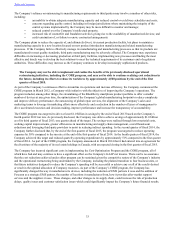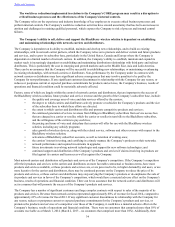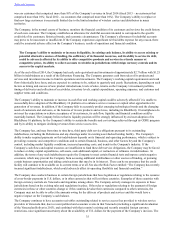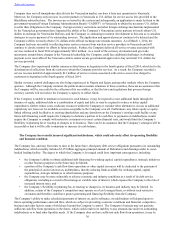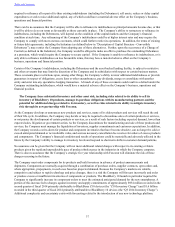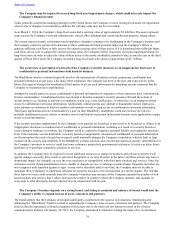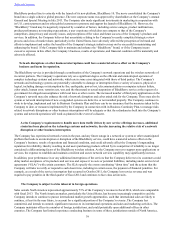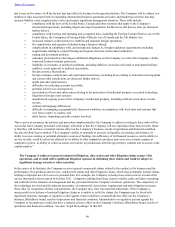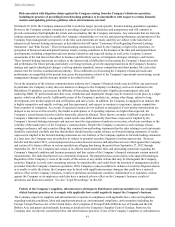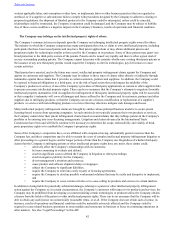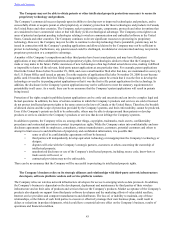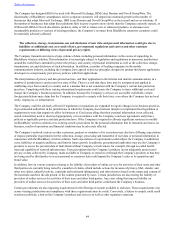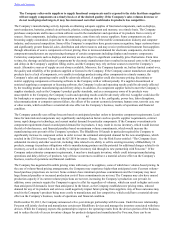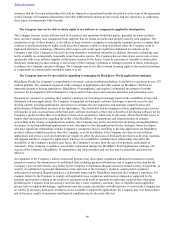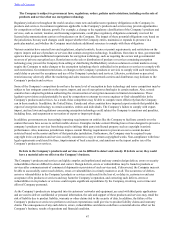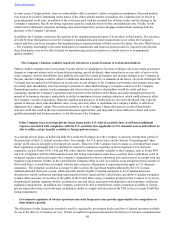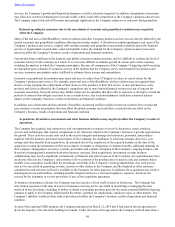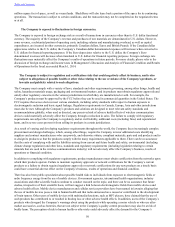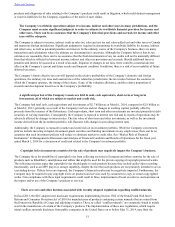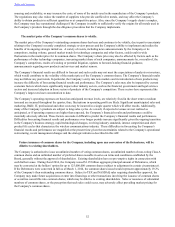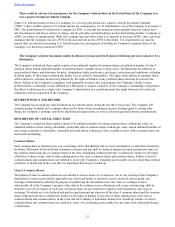Blackberry 2014 Annual Report Download - page 51
Download and view the complete annual report
Please find page 51 of the 2014 Blackberry annual report below. You can navigate through the pages in the report by either clicking on the pages listed below, or by using the keyword search tool below to find specific information within the annual report.
43
The Company may not be able to obtain patents or other intellectual property protections necessary to secure its
proprietary technology and products.
The Company’s commercial success depends upon its ability to develop new or improved technologies and products, and to
successfully obtain or acquire patent or other proprietary or statutory protection for these technologies and products in Canada,
the United States and other countries. The Company seeks to patent concepts, components, protocols and other inventions that
are considered to have commercial value or that will likely yield a technological advantage. The Company owns rights to an
array of patented and patent pending technologies relating to wireless communication and embedded software in the United
States, Canada and other countries. The Company continues to devote significant resources to protecting its proprietary
technology. However, the Company may not be able to continue to develop technology that is patentable, patents may not be
issued in connection with the Company’s pending applications and allowed claims by the Company may not be sufficient to
protect its technology. Furthermore, any patents issued could be challenged, invalidated or circumvented and may not provide
proprietary protection or a competitive advantage.
A number of the Company’s competitors and other third parties have been issued patents, and may have filed patent
applications or may obtain additional patents and proprietary rights, for technologies similar to those that the Company has
made or may make in the future. Public awareness of new technologies often lags behind actual discoveries, making it difficult
or impossible to know all the relevant, third-party patent applications at any particular time. For example, patent applications
filed in the United States before November 29, 2000, and even a small number filed after that date, are maintained in secrecy by
the U.S. Patent Office until issued as patents. Even the majority of applications filed after November 29, 2000 do not become
public until 18 months after their first filing. Consequently, the Company cannot be certain that it was the first to develop the
technology covered by its pending patent applications or that it was the first to file patent applications for the technology. In
addition, the disclosure in the Company’s patent applications may not be sufficient to meet the statutory requirements for
patentability in all cases. As a result, there can be no assurance that the Company’s patent applications will result in patents
being issued.
Protection of the rights sought in published patent applications can be costly and uncertain and can involve complex legal and
factual questions. In addition, the laws of certain countries in which the Company’s products and services are sold or licensed
do not protect intellectual property rights to the same extent as the laws of Canada or the United States. Therefore, the breadth
of allowed claims and the scope of protection provided by the Company’s patents, and their enforceability, cannot be predicted.
Even if the Company’s patents are held to be enforceable, others may be able to design around these patents or develop
products or services similar to the Company’s products or services that do not infringe the Company’s patents.
In addition to patents, the Company relies on, among other things, copyrights, trademarks, trade secrets, confidentiality
procedures and contractual provisions to protect its proprietary rights. While the Company enters into confidentiality and non-
disclosure agreements with its employees, consultants, contract manufacturers, customers, potential customers and others to
attempt to limit access to and distribution of proprietary and confidential information, it is possible that:
• some or all of its confidentiality agreements will not be honored;
• third parties will independently develop equivalent technology or misappropriate the Company’s technology or
designs;
• disputes will arise with the Company’s strategic partners, customers or others concerning the ownership of
intellectual property;
• unauthorized disclosure or use of the Company’s intellectual property, including source code, know-how or
trade secrets will occur; or
• contractual provisions may not be enforceable.
There can be no assurance that the Company will be successful in protecting its intellectual property rights.
The Company’s business relies on its strategic alliances and relationships with third-party network infrastructure
developers, software platform vendors and service platform vendors.
The Company relies on wireless network infrastructure developers for access to emerging wireless data protocols. In addition,
the Company’s business is dependent on the development, deployment and maintenance by third parties of their wireless
infrastructure and on their sales of products and services that use the Company’s products. Market acceptance of the Company’s
products also depends on support from third-party software developers and the marketing efforts of value added resellers,
Internet service providers and computer manufacturers and distributors. The loss of, or inability to maintain, any of these
relationships, or the failure of such third parties to execute or effectively manage their own business plans, could result in
delays or reductions in product shipments, which could have a material adverse effect on the Company’s business, results of
operations and financial condition.
Table of Contents


